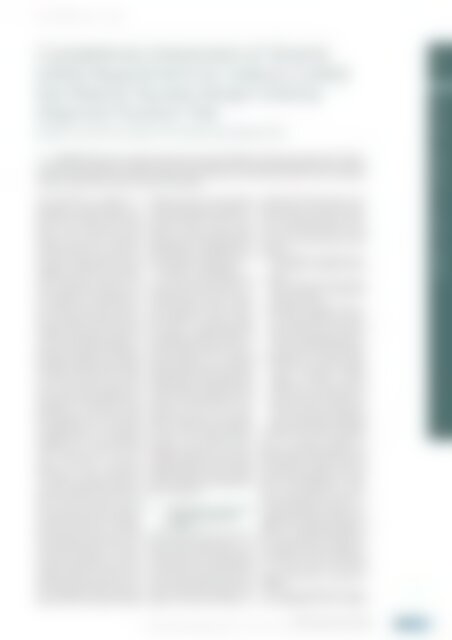atw 2015-01
You also want an ePaper? Increase the reach of your titles
YUMPU automatically turns print PDFs into web optimized ePapers that Google loves.
<strong>atw</strong> Vol. 60 (<strong>2<strong>01</strong>5</strong>) | Issue 1 ı January<br />
Completeness Assessment of General<br />
Safety Requirements for Sodium-Cooled<br />
Fast Reactor Nuclear Design Utilizing<br />
Objective Provision Tree<br />
Namduk Suh, Moohoon Bae, Yongwon Choi, Bongsuk Kang and Huichang Yang<br />
1. Introduction The Korea Atomic Energy Research Institute (KAERI) is developing a Prototype Gen-IV Sodiumcooled<br />
Fast Reactor (PGSFR) of 150 MWe size with a plan to apply the construction permit by 2020. The Korea Institute<br />
of Nuclear Safety (KINS) is performing a regulatory research to prepare the licensing of this future reactor, developing<br />
regulatory requirements and safety analyses methodologies.<br />
The development of regulatory requirements<br />
is needed because in a<br />
prescriptive regulatory framework adopted<br />
by the countries like United<br />
States or Korea, licensing review of<br />
nuclear power plant is performed<br />
evaluating whether the design satisfies<br />
the prescriptive design criteria or<br />
regulatory requirements previously<br />
established. For this, U.S. Nuclear Regulatory<br />
Commission (NRC) has the<br />
well established General Design Criteria<br />
(GDC) [1] for Light Water Reactor<br />
(LWR) that served for many decades<br />
in assuring the safety of the nuclear<br />
power plant. The GDC is top level<br />
regulatory requirements enforced by<br />
law. The corresponding regulatory requirements<br />
for LWR are stipulated in<br />
the Korean “Regulations on Technical<br />
Standards for Nuclear Reactor Facilities”<br />
which has the same level of binding<br />
force and similar contents with<br />
those of GDC. Thus, preparing the licensing<br />
of PGSFR requires first of all a<br />
development of GDC like General<br />
Safety Requirements (GSR) for SFR.<br />
The approach we use in developing<br />
the GSR for SFR is 1) to evaluate the<br />
applicability of the current LWR GSR<br />
to SFR and 2) to reflect the other<br />
safety requirements for SFR, developed<br />
by Gen-IV International<br />
Forum (GIF) or American Nuclear Society<br />
(ANS). Following this approach<br />
we have developed a draft version of<br />
SFR GSR with 59 articles. The next<br />
step is to assess the draft versions for<br />
its completeness and the normal approach<br />
is to depend on the engineering<br />
judgement of experts. The NRC’s<br />
GDC is developed also based on the<br />
accumulated experiences of LWR licensing<br />
and operation, but unfortunately<br />
the similar experiences are not<br />
available for SFR. To assure that the<br />
developed GSR includes all the necessary<br />
requirements and guarantee the<br />
safety of SFR from Defence-in-Depth<br />
(DID) point of view, we have decided<br />
to utilize the Objective Provision Tree<br />
(OPT) methodology developed by International<br />
Atomic Energy Agency<br />
(IAEA) [2]. We found that this methodology<br />
provides a systematic and integral<br />
approach in complementing the<br />
GSR developed referencing the current<br />
requirements of similar kind.<br />
The OPT is a methodology to ensure<br />
and document the provision of<br />
essential “lines of protection” for successful<br />
prevention, control or mitigation<br />
of phenomena that could potentially<br />
damage the nuclear system.<br />
[2,3] The OPT is normally developed<br />
by designer to confirm whether the<br />
design fulfills the DID concept, but we<br />
have developed the OPT to apply it in<br />
assessing whether there is missing<br />
safety requirements in our GSR under<br />
development from DID concept. In the<br />
following section, we first describe the<br />
strategy of GSR development for SFR<br />
and the next section presents the development<br />
of OPT. Then, the completeness<br />
assessment on the requirements<br />
of nuclear design utilizing the<br />
“reactivity control” safety function is<br />
presented in the following section.<br />
Through out this paper, we will use a<br />
terminology GSR for common understanding,<br />
instead of GDC or Technical<br />
Standards which are used in the regulation<br />
of United States and Republic of<br />
Korea, respectively.<br />
2. Development of general<br />
safety requirements<br />
for SFR<br />
This section describes the position of<br />
general safety requirements in the<br />
framework of Korean atomic law system<br />
and then how we have developed<br />
the draft version of the SFR GSR. The<br />
current Korean legal framework for<br />
nuclear safety regulation has 4 levels.<br />
The nuclear safety act positions at the<br />
highest level and then follows, sequentially,<br />
enforcement decree of the<br />
nuclear safety act, enforcement regulation<br />
of the nuclear safety act, regulations<br />
on technical standards for nuclear<br />
reactor facilities. Basic concept<br />
and role of act and decrees are the<br />
following:<br />
1) Nuclear safety act stipulates the basic<br />
principles concerning nuclear<br />
safety<br />
2) Enforcement decree of the nuclear<br />
safety act stipulates the particulars<br />
entrusted by the act<br />
3) Enforcement regulation of the nuclear<br />
safety act stipulates the particulars<br />
entrusted by the Act and/or<br />
Decree and necessary for their enforcement<br />
(including detailed procedures<br />
and format of documents)<br />
4) Regulations on Technical Standards<br />
for Nuclear Reactor Facilities<br />
stipulate conceptual technical<br />
standards as entrusted by the Act<br />
and/or Decree. It contains also the<br />
details on technical standards, procedures<br />
or format as entrusted by<br />
the Act, Decree and/or Regulations<br />
Thus, the GSR which corresponds<br />
to LWR GDC of U.S. NRC is the regulations<br />
on Technical Standards in<br />
Korean atomic legal framework. This<br />
GSR for SFR is developed referencing<br />
the LWR GSR, so the first step is to<br />
evaluate the applicability of the LWR<br />
GSR to SFR. Performing the evaluation<br />
we could classify the requirements<br />
of LWR GSR into 3 groups, i.e.,<br />
1) LWR requirements which are not<br />
applicable to SFR, thus need to be excluded,<br />
2) requirements applicable to<br />
SFR as it is, 3) requirements needed to<br />
be revised/amended. In addition to<br />
this, taking into account the SFR specific<br />
features, there are requirements<br />
to be newly added. The overall<br />
strategy and process are depicted in<br />
Figure 1.<br />
In revising/amending the current<br />
LWR requirements and to identify<br />
ENERGY POLICY, ECONOMY AND LAW 27<br />
Energy Policy, Economy and Law<br />
Assessment of General Safety Requirements for SFR ı Namduk Suh, Moohoon Bae, Yongwon Choi, Bongsuk Kang and Huichang Yang

















